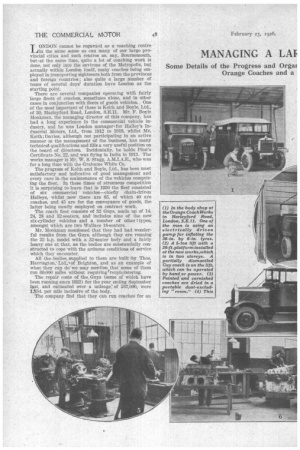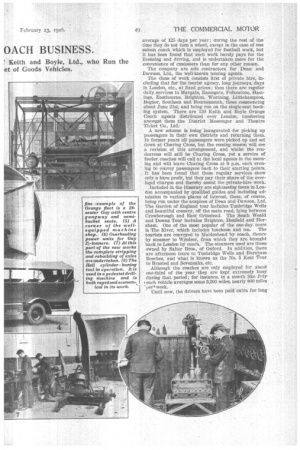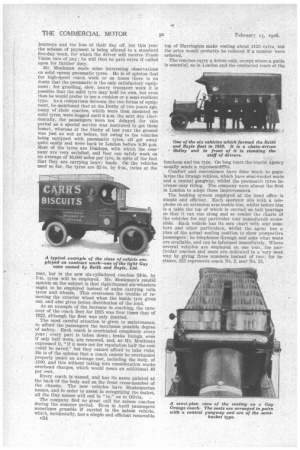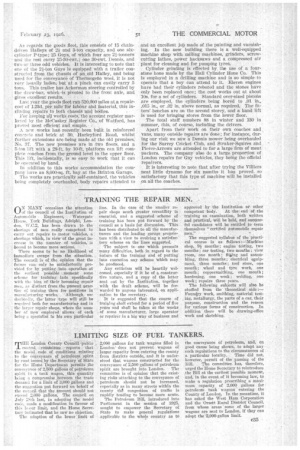MANAGING A LAF OACH BUSINESS.
Page 16

Page 17

Page 18

Page 19

If you've noticed an error in this article please click here to report it so we can fix it.
Some Details of the Progress and Orgar Orange Coaches and a
Keith and Boyle, Ltd„ who Run the et of Goods Vehicles. T ONDON cannot be regarded as a coaching Centre
the same sense as can many of our large provincial cities and such centres as, say, Bournemouth, but tat the same time, quite a lot of coaching work is done, not only into the environs of the Metropolis, but actually within London itself, many coaches being employed in transporting sightseers both from the provinces and foreign countries; also quite a large number of tours of several days' duration have London as the starting point.
There are several companies operating with fairly large fleets of coaches, sometimes alone, and in other cases in conjunction with fleets of goods vehicles.. One of the most important of these is Keith and Boyle, Ltd., of 30, Harleyford Road, London, S.E.11. Mr. F. Boyle Monkman, the managing director of this company, has had a long experience in the commercial vehicle industry, and he was London manager for Halley's Industrial Motors, Ltd., from 1912 to 1919, whilst Mr, Keith; Davies, although not participating in an active manner in the management of the business, has many technical qualifications and fills a very useful position on the board of directors. Incidentally, he holds Pilot's Certificate No. 22, and was flying in India in 1911. The works manager is Mr. W. S. Stagg, A.M.I.A.E., who was for a long time with the Grahame White Co.
The progress of Keith and Boyle, Ltd., has been most satisfactory and indicative of good management and every care in the maintenance of the vehicles comprising the fleet. In these times of strenuous competition it is surprising tolearn that in 1920 the fleet consisted of six commercial vehicles—chiefly chain-driven Halleys, whilst now there are 85, of which 40 are coaches, and 45 are for the conveyance of goods, the latter being mostly employed on contract work.
The coach fleet consists of 32 Guys, made up of 14, 24, 28 and 32-seaters, and includes nine of the new six-cylinder vehicles and a number of other types, amongst which are two Wallace 18-seaters.
Mr. Monkman mentioned that they had had wonderful results from the Guys, although they are running the 25 h.p. model with a 32-seater body and a fairly heavy one at that, as the bodies are substantially constructed to cope with the arduous conditions of service which they encounter.
All the bodies,, supplied to them are built ,by Thos. Harrington, Ltd:,N of Brighton, and as an example of what they can do' we maymention that' some of -them run 60.000 mites without requirinereupholstering,
The repair costs of the, Guys (some of which have been running since 1922) for the year ending September last, and estimated over a mileage of 267,000, were 1.35th per mile inclusive of the body.
The company find that they can run coaches for an
average of 125 days per year ; during the rest of the time they do not turn a wheel, except in the case of one saloon coach which is employed for football work, but it has been found that such work barely pays for the licensing and driving, and is undertaken more for the convenience of customers than for any other reason. The company are sole contractors for Dean and . Dawson, Ltd., the well-known touring agents.
The class of work consists first of private hire, including that for the tourist agency, bang journeys, days in London, etc., at fixed prices ; then there are regular daily services to Margate, Ramsgate, Folkestone, Hastings, Eastbourne, Brighton, Worthing, Littlehampton, Bognor, Southsea and Bournemouth, these commencing about June 21st, and being run on the single-seat booking system. There are 120 Keith and Boyle Orange Coach agents distributed over London, numbering amongst them the District Messenger and Theatre Ticket Co., Ltd.
A new scheme is being inaugurated for picking up passengers in their own districts and returning them. In former years all passengers were picked up and set down at Charing Cross, but the coming season will see a revision of this arrangement, and whilst the rendezvous will still be Charing Cross, yet a service of feeder coaches will call at the local agents in the morning and will leave Charing Cross at 9 p.m. each evening to convey passengers back to their starting points. It has been found that these regular services show only a bare profit, but they pay their share of the over lied and thereby assist the private-hire work.
.Included in the itinerary are sightseeing tours in London accompanied by qualified guides and including admission to various places of interest, these, of course, being run under the auspices of Dean and Dawson, Ltd. The Garden of England tour includes Tunbridge Wells and beautiful country, off the main road, lying between Crowborough and East Grinstead. The South Weald and Downs Tour Includes Brighton, Henfield and Horsham. One of the most popular of the one-day tours is The River, which includes luncheon and tea. The tourists are conveyed to Maidenhead by coach, thence by steamer to Windsor, from which they are brought back to London by coach. The steamers used are those owned by "Salter Bros., of Oxford. In addition, there are afternoon tours to Tunbridge Wells and Burnham Beeches, and what is known as the No. 5 Kent Tour to Brasted and Sevenoaks, etc.
Although the coaches are only employed for about one-third of the year they are kept extremely busy during that period ; for instance, in a month like July 4 each vehicle averages some 3,200 miles, nearly 800 miles
week.
Until now, the drivers have been paid extra for long
journeys and the loss of their day off, but this year the scheme of payment is being altered to a standard five-day week, for which the driver will receive Trade Union rate of pay; he will then be paid extra if called upon for further duty.
Mr. Monkman made some interesting observations on solid versus pneumatic tyres. He is of opinion that for high-speed coach work or on buses there is no doubt that the pneumatic is the only satisfactory equipment; for gruelling, slow, heavy transport work it is possible that the solid tyre may hold its own, but even then he would prefer to use a cushion or a semi-resilient type. As a comparison between the two forms of equipment, he mentioned that at the Derby of two years ago, many of their coaches, which were. then mounted on solid tyres, were bogged until 6 a.m the next day (incidentally, the passengers were not delayed for this period as a special service was instituted to get them home), whereas at the Derby of last year the ground was just as wet as before, but owing to the vehicles being equipped with pneumatic tyres, all got away quite easily and were back in London before 8.30 p.m. Most of the tyres are Dunlops, with which the corn-' pany are very satisfied, and they can safely work on an average of 16,000 miles per tyre, in spite of the fact that they are carrying heavy loads. On the vehicles used so far, the tyre.s are 32-in. by 6-in., twins at the
rear, but in the new six-cylindered coaches 34-in. by 7-in. tyres will be employed. Mr. Monlanan's candid opinion on the subject is that rigid-framed six-wheelers ought to be employed instead of axles carrying twin: tyres and wheels. This overcomes the trouble of removing the exterior wheel when the inside tyre gives out, and also gives better distribution of the load.
As an example of the increase in coaching, the turnover of the coach fleet for 1925 was four times that of 1922, although the fleet was only doubled.
' The most careful attention is given to maintenance, to afford the passengers the maximum possible degree of safety. Each coach is overhauled completely every year ; every part is taken down; brake linings, even if only half worn, are renewed, and, as Mr. Monkman expressed it, "if it were not for reputation half the cost could be saved," but they cannot afford to take risks. He is of the opinion that a coach cannot be overhauled properly under an average cost, including the body, of -1100, .and this without taking into consideration works overhead charges, which would mean an additional 40 per cent.
Every coach is named, and has its name painted at the back'of the body and on the front cross-member of the chassis. The new vehicles have Shakesperian names, and in order to assist in recognizing the makes, all the Guy names will end in "in," as in Olivia. The company find no great call for saloon coaches during the summer period. Even in April passengers sometimes grumble if carried in the saloon vehicle, which, incidentally, has a simple and efficient removable c34 top of Harrington make costing about 1120 extra, but the price would' probably be reduced if a number were ordered.
The coaches carry a driver only, except where a guide is essential, as in London and the conducted tours of the luncheon and tea type. On long tours the tourist agency usually sends a representattve.
Comfort and convenience have done much to popularize the Orange vehices, which have semi-bucket seats and a central gangway, whilst the pneumatic tyres increase easy riding. The company were almost the first in London to adopt these improvements.
The booking system employed at the head office is simple and efficient. Each operator sits with a telephone on an extension arm beside him, whilst before him is a table the top of which is carried on ball bearings so that it can run along and so render the charts of the vehicles for any particular tour immediately accessible. Each vehicle has its own chart with seat numbers and other particulars, whilst the agent has a plan of the actual seating position to show prospective passengers ; he telephones through and asks what seats are available, and can be informed immediately. Where several vehicles are employed on one tour, the particular coaches and seats are indicated in a 'very neat way by giving three numbers instead of two; for instance, 225 represents coach No. 2, seat No. 25. As regards the goods fleet, this consists of 15 chaindriven Halleys of 2i• and 3-ton capacity, and one sixcylinder P-type; 25 Guys, of which four are 21-tonners and the rest carry 25-30-cwt.; one 30-cwt. Dennis, and two or three odd vehicles. It is interesting to note that one of the 21-ton Guys is equipped with a trailer constructed from the chassis of an, old Halley, and being used for the conveyance of Thermogene wool, it is not yery heavily laden; but* at a Pinch Can easily carry .5 tons: This trailer has Ackerman steering controlled by the draw-bar, which .is pivoted to the front axle, and gives excellent results.. • • • • .
Last year the goods fleet. ran 520,000 miles at.a repaircost of 1:23d..per mile for labOur and material this in For k-ee. ping a1,1 works costs :.the accoantregister marketed by the McCaskeY Register Co., of Watford, has proved most effteient and simple.:.'., A new .works has recently. been built in reinforced connete and brick at 30, Harleyford Road, whilst further extensions are being made at the old premises, No. 37. The new premises are in two floors, and a 5-ton lift With a 28-ft. by 10-ft. platform can lift complete coaches from. the ground leVel to the upper floor. This lift, incidentally, is so easy to work that it can be operated by hand.
In addition to this works accommOdation the company have an 8,000-sq. ft. bay at the Brixton. Garage.
The works are practically self-contained, the vehicles being completely overhatilecl, body repairs attended to
and an excellent job made of the painting and varnishing. In the new building_ there is a well-equipped machine shop with milling machines, grinders, screwcutting lathes, power hacksaws and a compressed air plant for cleaning and for pumping tyres. .
Cylinder grinding is effected by the use of a fourstone hone made by the Hall Cylinder Hone Co. This is employed in a drilling machine and. is so simple to operate that a boy can attend to it. Eleven engines have had their cylinders rebored and the stones have Only been replaced once; the cost works out at about 10s. for a set of cylinders. Standard over-sized pistons are employed, the cylinders being bored to .01 in., .015 in., or .02 in. above normal, as required. The fitters' -benches are on the second storey, and a hand lift is used for bringing stores from the lower .floor.
The total staff numbers 88 in winter and 130 in summer, this, of course, including the drivers, Apart from their work on their own coaches and , vans, many outside repairs are done; for instance, during our visit we saw a Dennis mower being overhauled for the Surrey Cricket Club, and Straker-Squires and Pierce-Arrows are attended to for a large firm of meat packers. The company also do a large proportion of London repairs for Guy vehicles, they being the Official repairers.
It is interesting to note that after trying the Villiers neat little dynamo for six months It has proved. so satisfactory that this type of machine will be installed on all the coaches.






























